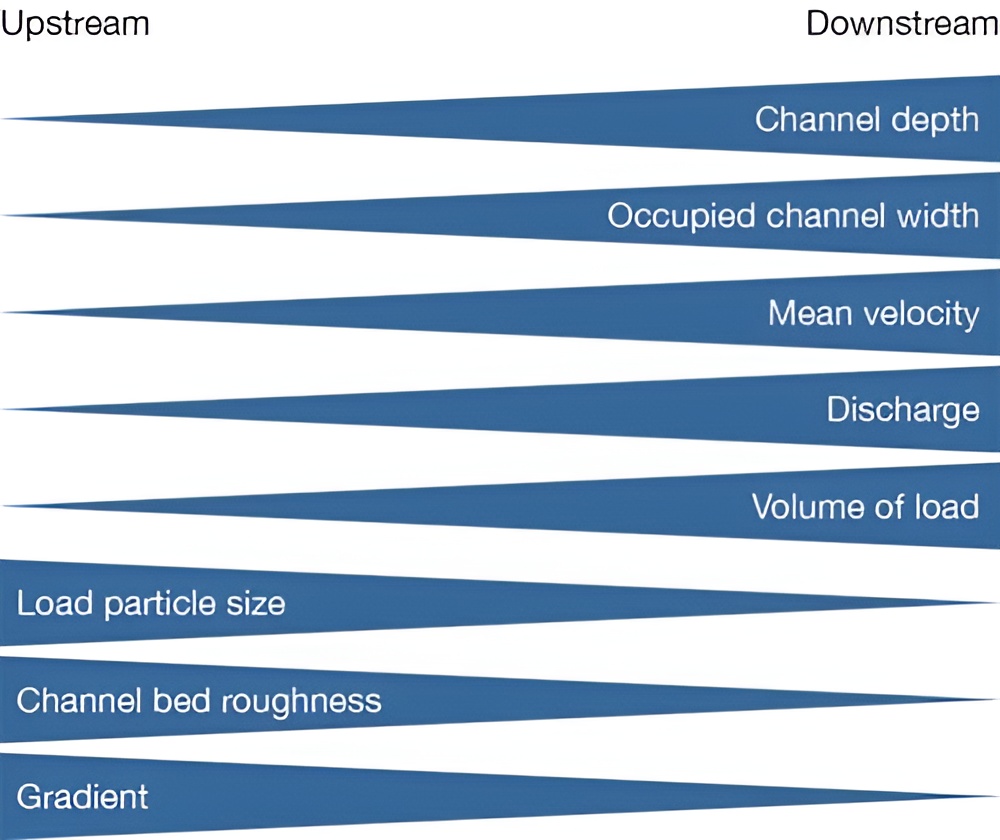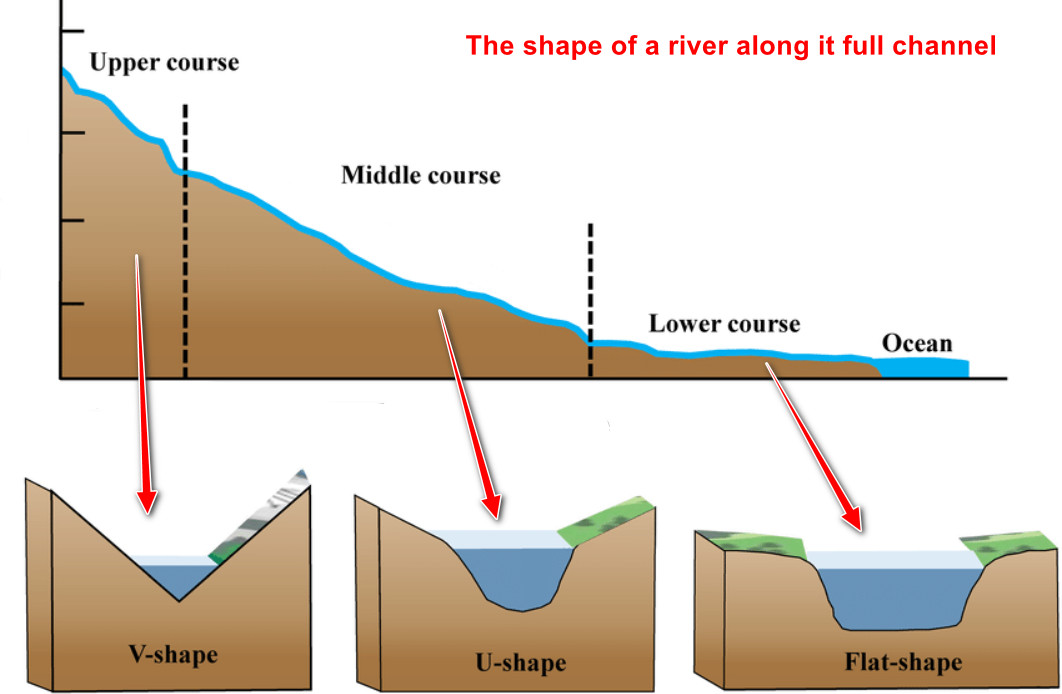What is the Bradshaw Model? #
The Bradshaw Model shows how river characteristics change as you move from the source (where the river starts) to the mouth (where the river ends). It was created by geographer Michael Bradshaw to help us understand patterns in rivers.
Think of it like this: a small mountain stream looks and behaves very differently from a wide river flowing through a city. The Bradshaw Model explains these differences in a simple way.

How River Characteristics Change Downstream #
As a river flows from its source to its mouth, several important characteristics change in predictable ways. The Bradshaw Model groups these into characteristics that increase, decrease, or stay roughly the same.
| River Characteristic | Change from Source to Mouth | Why This Happens |
|---|---|---|
| Channel Width | INCREASES | More tributaries join the river, making it wider |
| Channel Depth | INCREASES | More water flows through, making the channel deeper |
| Velocity (Speed) | INCREASES | Channel becomes more efficient and smoother |
| Discharge | INCREASES | More tributaries add water to the main river |
| Load Quantity | INCREASES | River picks up more sediment as it flows |
| Load Particle Size | DECREASES | Rocks get worn down and broken into smaller pieces |
| Channel Roughness | DECREASES | Riverbed becomes smoother with less rocks and boulders |
| Slope Gradient | DECREASES | Rivers flow from high mountains to flat coastal areas |
Understanding Each Characteristic #
Characteristics That Increase Downstream #
Channel Width and Depth: As more tributary rivers join the main river, there is much more water flowing through the channel. This extra water makes the river both wider and deeper. It’s like adding more water to a garden hose – you need a bigger hose to carry more water.
Velocity (Speed of Flow): Many people think rivers flow faster in mountains because they are steeper. However, the Bradshaw Model shows that rivers actually flow faster near their mouth. This happens because the channel becomes much smoother and more efficient at carrying water, even though the land is flatter.
Discharge: This means the volume of water flowing past a point per second (measured in cubic meters per second, or $\text{m}^3\text{/s}$). Discharge increases because more tributaries join the river, adding their water to the main channel.
Real River Example #
The River Thames in England is a good example. Near its source in the Cotswolds, it’s only a few meters wide. By the time it reaches London, it’s over 200 meters wide and much deeper. The discharge increases from just a few cubic meters per second to over 200 cubic meters per second.
Characteristics That Decrease Downstream #
Load Particle Size: “Load” means the rocks, sand, and mud that the river carries. Near the source, rivers carry large boulders and rocks. As the river flows downstream, these get broken down into smaller and smaller pieces through erosion processes. By the mouth, the river mainly carries fine sand and mud.
Channel Roughness: The riverbed becomes much smoother as you move downstream. In the upper course, the bed is full of large rocks and boulders that slow the water down. In the lower course, the bed is mainly smooth sand and mud.
Slope Gradient: Rivers start in high places (like mountains) and flow down to sea level. The slope becomes gentler as the river flows downstream, going from steep mountain slopes to almost flat coastal plains.

Why These Changes Happen #
The changes in the Bradshaw Model happen because of three main reasons:
- More tributaries join the river: Each tributary adds water, making the main river bigger and more powerful.
- Erosion processes wear down rocks: As water flows over rocks for many kilometers, it gradually breaks them into smaller pieces.
- The landscape changes: Rivers flow from high, steep mountains to low, flat coastal areas.
Important for Exams: Remember that velocity increases downstream even though the gradient decreases. This is because the channel becomes much more efficient at carrying water, with smoother sides and less friction.
Exceptions to the Bradshaw Model #
While the Bradshaw Model shows general patterns, there can be exceptions:
- Waterfalls and rapids: These create temporary increases in velocity in the upper course
- Human modifications: Dams, channels, and flood defenses can change natural patterns
- Seasonal changes: During floods or droughts, the normal patterns might be different
- Local geology: Different rock types can create unusual patterns in specific areas
Summary for Exams #
The Bradshaw Model shows predictable changes in rivers from source to mouth:
- Increase: Width, depth, velocity, discharge, load quantity
- Decrease: Gradient, particle size, channel roughness
- Main causes: More tributaries joining, erosion wearing down rocks, changing landscape from mountains to coast
- Key surprise: Rivers flow faster near their mouth despite flatter land because channels become more efficient




